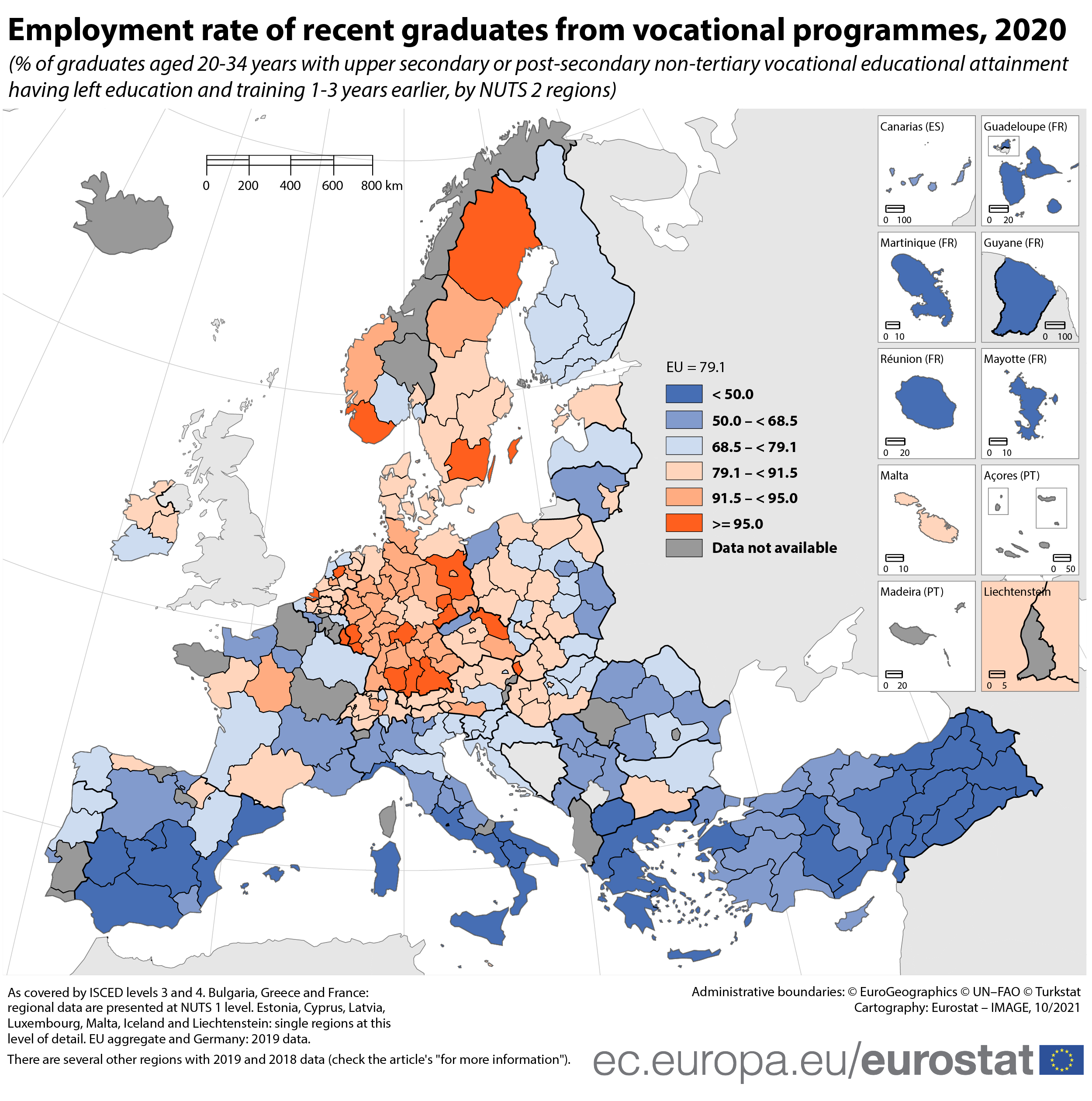National figures alone cannot reveal the full and sometimes complex picture of what is happening within the EU countries. The Eurostat regional yearbook provides a statistical overview of the regions of the EU across a broad range of subjects including the transition from education to work. The analyses presented are designed to highlight regional variations and similarities.
As highlighted in Eurostat’s regional yearbook, in 2019, the EU employment rate of recent graduates from vocational education programmes in upper secondary or post-secondary non-tertiary education (as covered by ISCED levels 3 and 4) was 79%. This employment rate was 3 percentage points (pp) below the 2025 EU-level objective for recent graduates from vocational programmes, which aims for at least 82% by 2025.
This rate has since changed to 76% in 2020, which is a decrease of 3 pp compared with 2019.
Source dataset: 03_Education_RYB2021
Among the 192 regions for which data are available (for mixed reference periods covering 2018-2020), there were five regions where all recent graduates successfully found work (100%). These were Flevoland and Zeeland in the Netherlands (both 2020 data), Luxembourg and its neighbouring region of Trier in Germany (both 2019 data), and Övre Norrland in Sweden (also 2019 data).
The lowest employment rates for recent vocational graduates were recorded in southern regions of the EU. There were 20 regions where less than half of all recent vocational graduates had found work and these were located in: Greece (all four NUTS level 1 regions), predominantly southern regions of Spain (2019 data for Extremadura), predominantly southern regions of Italy, as well as French overseas departments (2019 data). The lowest regional employment rates of recent graduates from vocational programmes were recorded in three Italian regions: Campania (33%), Calabria (26%) and Sicilia (25%).
Would you like to know more about education statistics in the EU?
- You can read more in the dedicated section of the Regions in Europe - 2021 interactive edition.
- You can also read more in the dedicated chapter of the Eurostat regional yearbook - 2021 edition.
- The corresponding maps in the Statistical Atlas provide a full-screen interactive map experience.
- There are also Eurostat Statistics Explained articles on vocational education and training statistics and employment rates of recent graduates.
- For the most recently available data on vocational graduates, see the dataset.
For more information:
- In this article, the regional data are presented at NUTS 2 level except for Bulgaria, Greece and France. Bulgaria, Greece and France regional data are presented at NUTS 1 level. Regional data for Estonia, Cyprus, Latvia, Luxembourg, Malta, Iceland and Liechtenstein: single regions at this level of detail.
- EU aggregate and Germany: 2019 data. There are several other regions with 2019 and 2018 data:
- 2019 data: Bulgaria: Yugozapadna i yuzhna tsentralna Bulgaria; Ireland: Northern and Western; Spain: Extremadura; France: Normandie, Grand Est, Nouvelle-Aquitaine, Occitanie, Auvergne - Rhône-Alpes, RUP FR - Régions ultrapériphériques françaises; Lithuania: Sostinės regionas; Luxembourg; Serbia: Småland med öarna, Övre Norrland; Montenegro.
- 2018 data: Spain: Comunidad Foral de Navarra; France: Centre-Val de Loire, Pays-de-la-Loire, Provence-Alpes-Côte d'Azur; Slovakia: Bratislavský kraj; Serbia: Mellersta Norrland.
- Data not available for these regions: Belgium: Région de Bruxelles-Capitale/ Brussels Hoofdstedelijk Gewest, Prov. Brabant Wallon, Prov. Luxembourg (BE), Prov. Namur; Spain: Cantabria, La Rioja, Ciudad Autónoma de Ceuta, Ciudad Autónoma de Melilla; France: Bourgogne - Franche-Comté, Hauts-de-France, Bretagne, Corse; Italy: Valle d’Aosta/Vallée d’Aoste, Molise; Austria: Burgenland; Portugal: Algarve, Alentejo, Região Autónoma dos Açores, Região Autónoma da Madeira; Romania: Bucureşti-Ilfov, Vest; Finland: Åland; Iceland; Liechtenstein; Norway: Hedmark og Oppland, Trøndelag, Nord-Norge’; Albania.
- Regions and cities, overview page on the Eurostat website
- Education and training, overview page on the Eurostat website
- Eurostat Regions and cities illustrated
- Eurostat application “My Region” (web and mobile app)
To contact us, please visit our User Support page.
For press queries, please contact our Media Support.


